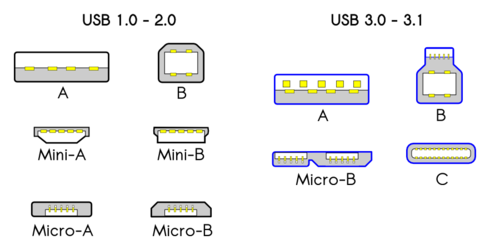
The USB port has been an industry standard for connection in nearly every electronic device for decades. Sure, it’s not the most exciting thing in the world related to computers, but it is an important one. The USB port has gone through so many physical form factor changes along with different versions that it can be sometimes tough to differentiate between every single one of them. If we were to talk to about all types of USB ports ever made and every generation of USB, you’d probably close this article because of how long it would be. The purpose of this simple article is to inform you of different USB types, different generations, and how to add in USB more ports to your PC.
So should you care about transfer speeds and power delivery throughout different generations?Depends on your use case. If you rarely connect external drives for transferring data, you can still get by with USB 2.0 for connecting your external devices. We can’t deny the increase in performance over generations and if you do transfer a large number of files using external storage devices, you would benefit from USB 3.0 and even 3.1 Gen2. Of course, 3.1 Gen2 will slowly become the standard in most computers sooner rather than later.
USB 2.0 is the most common version of the USB standard we use every day. The transfer rate is extremely slow, maxing out at 480 megabits/s (60MB/s). Of course, this is a bit slow for data transfer but for connecting peripherals such as keyboards, mice or headsets, the speed is sufficient. Slowly, USB 2.0 is being replaced by 3.0 in many high-end motherboards.
USB 3.0 has gradually become the new standard for USB devices by providing a lot of improvements over USB 2.0. These types of USB are distinguishable by their blue colored inserts and usually equipped with a 3.0 logo. USB 3.0 is miles ahead of 2.0 maxing out at almost 5 megabits/s (625MB/s) which is over 10 times faster. This is quite impressive.
USB 2.0 vs 3.0 vs 3.1A generation change in technology mostly means boosted performance. Same is the true for USB generations. There is USB 2.0, 3.0, 3.1 Gen1 and the latest 3.1 Gen2. As mentioned before the main difference is in terms of speed, let’s quickly run through all of them.

USB 3.1 started making its appearance all the way back in January of 2013. This port is still not as common today. It was announced alongside the new Type-C form factor. First off let’s get some confusion out of the way. USB 3.0 and 3.1 Gen1 are both exactly the same ports. Same rate of transfer, power delivery, everything. 3.1 Gen1 is just a rebrand of 3.0. So, if you ever see a Gen1 port don’t get misguided as if its faster than USB 3.0. With that out of the way, let’s talk about Gen2. USB 3.1 Gen2 is twice as fast as USB 3.0 and 3.1 Gen1. The transfer speed roughly translates to 10 Gigabits/s (1.25GB/s or 1250MB/s). This is an impressive performance from a USB port considering most SATA SSDs can’t even utilize that speed to its maximum. Sadly, this is still taking its time to come to the mainstream market. We are seeing its rise in the laptop area so hopefully, more desktop motherboards will come out with this port. Every 3.1 port is backward compatible with 2.0 connectors.
Shenzhen SHOUHAN tech is a professional manufacturer of USB connector,we‘d like to help customer to choose the most suitabe parts for your project,any questions pls contact us,thank you !
Post time: Aug-18-2021












